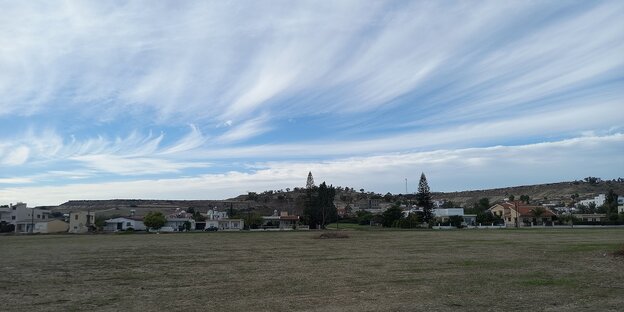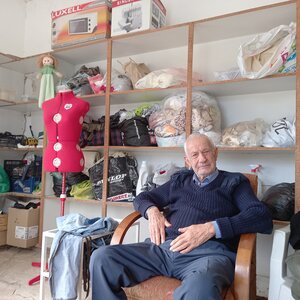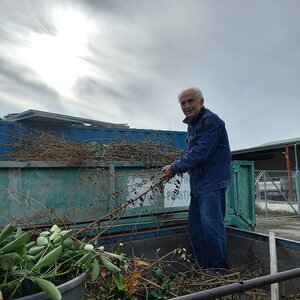Last summer, a street dispute in Cyprus caused a global stir. Some feared a new war. What does it look like there today?

Under a calm sky: the city of Pyla in Cyprus, where Greeks and Turks coexist Photo: Ferry Batzoglou
PYLA taz | Osman Mustafa, 85 years old, freshly shaved, neatly dressed, with his hands together, exudes a pleasant calm. In his small tailor shop located in the town square of Pyla, an old sewing machine from the legendary Singer company makes noise. She is served by an older woman, an Uzbek. Osman Mustafa watches his work calmly.

Turkish tailor Osman Mustafa Photo: Ferry Batzoglou
When Osman Mustafa was born, Cyprus was still a British crown colony. He is a Turkish Cypriot. “Whether Christians or Muslims: we are all human,” he says. Osman Mustafa says this in Greek. That's typical. The city's older Cypriot Turks speak both languages: Turkish and Greek. As always, they sit and chat with their Greek Cypriot neighbors in local cafes and taverns.
It's different for the younger people in the city. Cankut Findik, 28, with three days of stubble, has just arrived home. The web designer still lives at his parents' house, at the entrance to Pyla. Although he works in Larnaca, in the south of the island, he does not know Greek, admits Cankut Findik. This is typical of his generation of young Cypriot Turks, he underlines. However, the people live peacefully with the other ethnic group.
Only Cypriot city with mixed population
british protectorate
Britain annexed Cyprus in November 1914. Greek Cypriots launched a guerrilla war against the British occupiers in April 1955. They fight for the island's independence and unification with Hellas. Cyprus became independent in August 1960.
Cyprus conflict 1974
From Christmas 1963 onwards there were riots between Greek Cypriots and Turkish Cypriots. The bloody events are considered a harbinger of the escalation of the Cyprus conflict in the summer of 1974. Cypriot National Guard officers staged a coup d'état in Athens on 15 July 1974 with the help of the Greek military junta against the president of Cyprus, the archbishop. Makarios III. Their objective: the annexation of Cyprus to Greece. Türkiye intervenes. On July 20, 1974, regular Turkish troops landed in the north of the island. The Turkish army occupied 37 percent of the island's area in mid-August.
Island division
The “Turkish Republic of Northern Cyprus”, proclaimed in 1983, is only recognized by Turkey. The Republic of Cyprus, which de facto only controls the south of the island, became a member of the EU in 2004 and joined the eurozone in 2008. In northern Cyprus, the Turkish lira remains the official currency. The last bilateral talks to resolve the Cyprus issue failed in mid-2017. The north of the island has 350,000 inhabitants and the south 900,000. Nicosia is the last divided capital of the world.
The village of Pyla (Turkish: Pile) is unique. Pyla is the only mixed city with Greek Cypriots and Turks left in Cyprus. It happened like this: in the summer of 1974, Turkish soldiers stopped shortly before Pyla. The city, with around a thousand inhabitants, is located in the southeastern corner of Cyprus. Due to its proximity to the occupied north, Pyla is included in the buffer zone. The “Green Line”, no man's land, crosses the island.
Pyla has a Greek Cypriot and a Turkish Cypriot mayor. The blue and white Greek flag flies in front of one primary school, and the one with the red crescent moon flies in front of the other primary school, a stone's throw away. In addition to three Orthodox churches, there is a mosque. Pyla/Pile is guarded by the multinational UN peacekeeping mission for Cyprus (UNFICYP). The “blue helmets” follow life in the town square from the roof of a tavern. Normally the rule for them is to kill time. No special incidents.
But UN soldiers suddenly found themselves very busy on a scorching hot day in mid-August last year. “Special operations forces,” according to the Turkish Cypriot news site “Haber Kibris,” are using bulldozers to ram white jeeps parked in rows with the capital letters “UN” on the front door in a large area in the buffer zone. by Pyla. They then begin removing coils of barbed wire tied to the sandy ground and attack the gathered UN soldiers. An absurdity. Three UN soldiers are injured. The disturbing images go around the world.
Road expansion as a cause of conflict
The “Minister of Foreign Affairs” of the “Turkish Republic of Northern Cyprus”, Tahsin Ertuğruloğlu, later defended the violent actions. According to him, it is necessary to “improve and expand” a 11.6 kilometer-long road from the city of Arsos (Turkish: Yigitler), in the north of the island, to Pyla. UNFICYP immediately condemns the attacks in the strongest possible terms. Successfully. The street dispute literally comes to nothing.

The Greek Polydoros Georgiou Photo: Ferry Batzoglou
Polydoros Georgiou, a Greek Cypriot, dressed in jeans and a denim jacket, still very cheerful for his eighties, stands on the back of his flatbed truck on this wonderfully warm Sunday morning in December. He says that he has already pruned the trees in his garden. He now removes dead branches at a facility located on a wide road that runs from the center of Pyla to a large Orthodox church.
Could the situation have become critical in the summer and possibly gotten worse? Was there a threat of a new war in Cyprus, almost fifty years after the de facto division of Cyprus? “Ochi, ochi” (“No, no”), Polydoros Georgiou quickly responds. “This is the United Nations. They guarantee peace and tranquility.”
Peaceful coexistence
On the other side of Pyla, Georgios Kaoullas, 58, bearded and outgoing, sees the issue of street conflict in the same way. “Here we are not in Gaza! “Pyla is not Palestine.” In the town itself, the incident in the buffer zone was not even noticed, claims the villager, a Greek Cypriot. Without further ado, Kaoullas makes it clear: The two ethnic groups get along very well in the area. Coexistence works. He goes one step further. For him, Pyla is a “role model for all of Cyprus”.
The sinister street dispute in Pyla/Pile in mid-August was just “a flash in the pan,” agrees Cankut Findik, the young web designer. The inhabitants of Pyla did not participate at all, he emphasizes. “It was all just a media show. Completely exaggerated. Nothing more,” says Cankut Findik. His father, Hussein Findik, nods. Other villagers see it the same way if you ask them about it.
Smuggling unites Greeks and Turkish Cypriots
There is something else that unites Greek Cypriots and Turkish Cypriots in Pyla: smuggling is flourishing. The breeding ground for this is ideal: a pack of cigarettes costs five euros in southern Cyprus. On the other hand, in the north, where the Turkish lira is the official currency, it is available for the equivalent of only 2.30 euros. In addition, fuel, food, drinks and all kinds of household items are much cheaper in the north, a stone's throw from Pyla, than in the south.
Every day people travel north from Pyla to do cheap shopping. The only thing they need is car insurance issued by the Turkish Cypriot authorities. It costs about 200 euros a year. Other controls? None. Both Greek Cypriot and Turkish Cypriot police officers do not have access to the village located in the buffer zone. For smugglers, whether small or large, this means: free rein!
Pyla is also located on the migrant route. Refugees use the route from northern Cyprus to Pyla to reach the EU. About a hundred maids and nurses from Vietnam and the Philippines work in the city, perhaps even more, according to a resident of Pyla who prefers to remain anonymous. He points out two gambling dens. There are many of them in Pyla. In the south of the island they are prohibited, but in Pyla the gambling industry is flourishing. Safety pin. Thanks to the buffer zone.